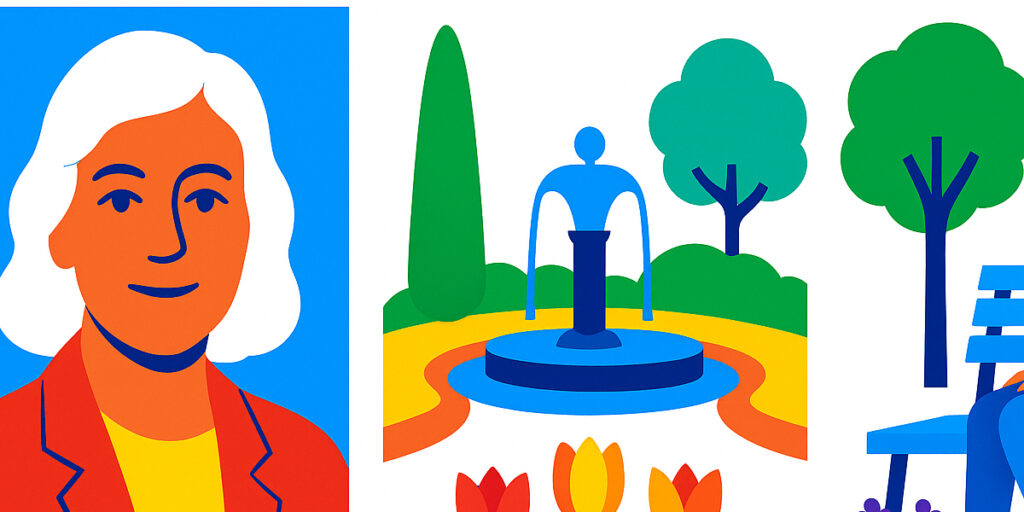Lynden Miller’s journey is a story of resilience, renewal, and radiant color. Her world was built not with bricks, but with blossoms. Through her vision, neglected corners of New York City bloomed into public sanctuaries, where nature and people found each other again. Her art was not displayed on gallery walls but unfolded beneath open skies, between winding paths, and along benches warmed by sun and community.
She didn’t begin her life as a gardener. Her roots were elsewhere, in art and painting. A trained artist, she once stood behind canvases instead of flowerbeds. But life has a way of nudging people into unexpected yet perfect places. Lynden found hers when her mother’s garden in Connecticut became a source of comfort and inspiration. There, something stirred—a realization that color, form, and texture could live not just in oils and frames, but in petals and leaves, in the way shadows moved through groves, in the chorus of perennials returning year after year.
In the heart of New York City, a place more famous for skyscrapers than sunflowers, gardens had lost their soul. Time, neglect, and changing priorities had drained their spirit. Once vibrant community spaces had wilted into gray, unused patches. Lynden looked at those spaces not with sorrow, but with promise. She saw what they could be—safe, beautiful, inclusive places where everyone, regardless of age or background, could feel welcome. She wasn’t just planting flowers. She was planting hope, color, dignity.
The Central Park Conservatory Garden became her first great canvas. Not a small task, and not a quiet one. The garden was tired, overgrown, and nearly forgotten. But Lynden didn’t flinch. She gathered ideas, built trust, and poured her energy into redesigning it with a focus on beauty and belonging. She introduced bold swaths of color, carefully layering textures and shapes that changed gracefully with the seasons. The effect was immediate—suddenly, people returned. Tourists, joggers, families, couples, readers, daydreamers—all found a place among the tulips and hedges. She had brought the garden back to life, and with it, a piece of the city’s spirit.
Bryant Park came next—a shadowed and once-feared square in Midtown Manhattan that had become a symbol of urban decay. Many thought it couldn’t be changed. Lynden saw something different. She didn’t just think of plants. She thought of people. She wanted Bryant Park to feel alive. Her plantings were bold and cheerful, designed to soften the city’s hard edges. The park transformed. Office workers began taking their lunches there. Children ran through fountains. Artists sketched. Poets sat on benches. And the city, perhaps for the first time in decades, paused and smiled.
Lynden’s philosophy was simple and radical: gardens should be for everyone. She believed that public beauty is a right, not a luxury. That nature, well-tended and thoughtfully designed, could bring people together and elevate daily life. Her gardens were never locked away or precious. They were open arms, wild invitations, places to rest, to think, to feel.
She didn’t work in isolation. Lynden brought together donors, city officials, gardeners, and local communities. She built alliances that lasted. Her strength was not just her eye for design, but her heart for collaboration. She listened, learned, adjusted, and moved forward. She showed that it is possible to lead with grace and create with purpose.
Over time, more and more gardens in New York City began to carry her signature: the Women’s Garden at the New York Botanical Garden, the garden at the Cathedral of St. John the Divine, and many others. Each one was different, but each carried her deep belief in public beauty and access. Her gardens were structured but soft, colorful but balanced. They were designed not just to be seen, but to be felt.
Her influence reached far beyond planting beds. Lynden became a mentor, a speaker, and an advocate. She taught others that great gardens begin not with grand budgets or exotic plants, but with intention and care. She showed that urban spaces can hold wild grace. That flowers have power. That a daffodil in the right place can shift the way someone feels about a block, a city, or even themselves.
Lynden also understood the seasons, not just in gardens, but in life. She embraced change. She welcomed the challenges of aging landscapes, shifting climates, and evolving city needs. Her designs aged beautifully, just as she did—never static, always responding, always growing.
Her own story is woven into each of her gardens. In a shady grove, you might feel her quiet strength. In a sunny border bursting with orange and purple, you might glimpse her joy. In the elegant rhythm of tulips lining a path, you sense her artist’s eye, precise and passionate. And in the open gates of every public space she touched, you see her generosity.
Lynden’s legacy is one of transformation—not only of places, but of perspectives. She showed a hurried, concrete-covered city how to slow down and look again. To breathe. To care for shared spaces. Her gardens didn’t just change parks; they changed people. They invited connection. They made beauty ordinary and extraordinary all at once.
Even now, as her influence continues to spread through new generations of public gardeners and designers, her message is clear: beauty belongs to everyone. She gave New York City not just flowers and trees, but a new way to imagine public life. She built spaces where strangers could sit side by side, surrounded by color, wrapped in peace, and reminded—quietly, gently, powerfully—that they mattered.
Because that was Lynden’s real art. Not just in the soil, but in the soul of the city. Not just in gardens, but in the way people walk through them—together, touched by color, carried by care.




















